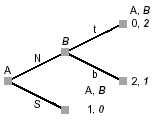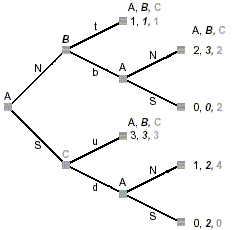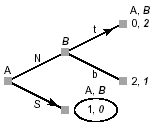Questions
Use backward induction to determine the subgame perfect equilibrium of the following games:Question 1

Question 2

Question 3

Solutions
Question 1
{ S ; t } with payoffs of (1,0).

Player A's equilibrium strategy is S; B's equilibrium strategy is "t if N." To characterize a subgame perfect equilibrium, one must find the optimal strategy for a player, even if the player is never called upon to use it. In this case, although player B never has to select between "t" and "b," the fact that the player would select "t" is what makes playing "S" an equilibrium for player A.
Question 2
{ N, N, N ; b ; d } with payoffs (2,3,2).

Starting at the end, Player A would select "N" in either of the last moves he may have to make. If player B is asked to make a decision, he selects b (knowing that player A will then select A). If player C is asked to make a decision, he selects d, knowing that player A will then select N. Now considering the first period, player A chooses N.
Question 3
{ S,S,N ; n,n,s } with payoffs of (4,5).
Start with the last decision and work backwards to the root of the tree. At each step, be careful to concentrate only on the payoffs of the player making the decision.


